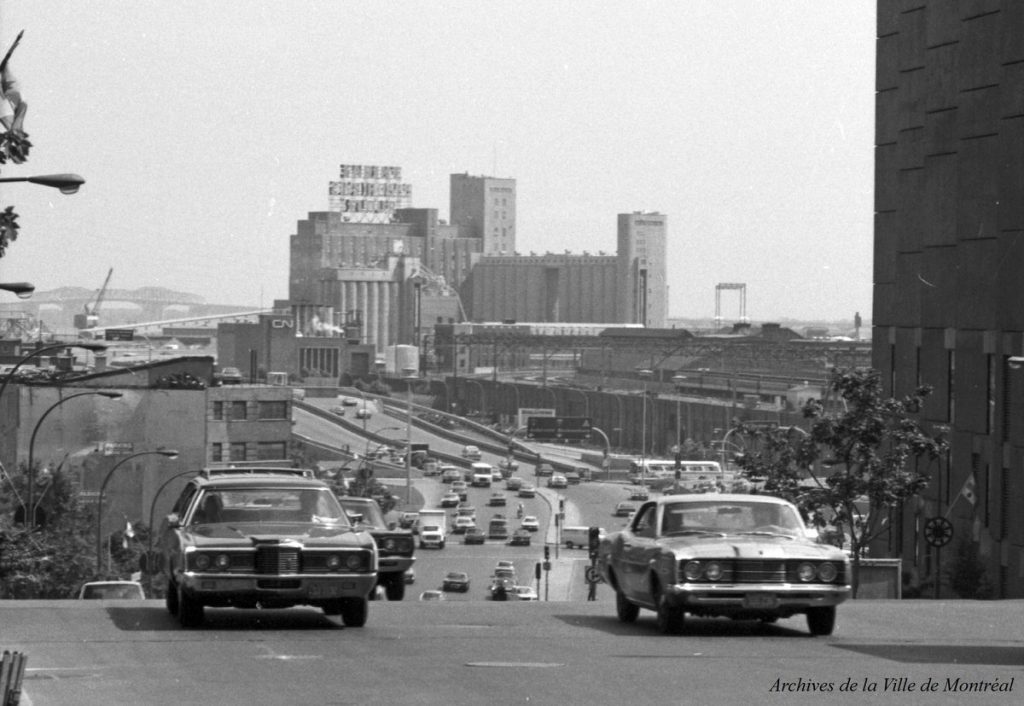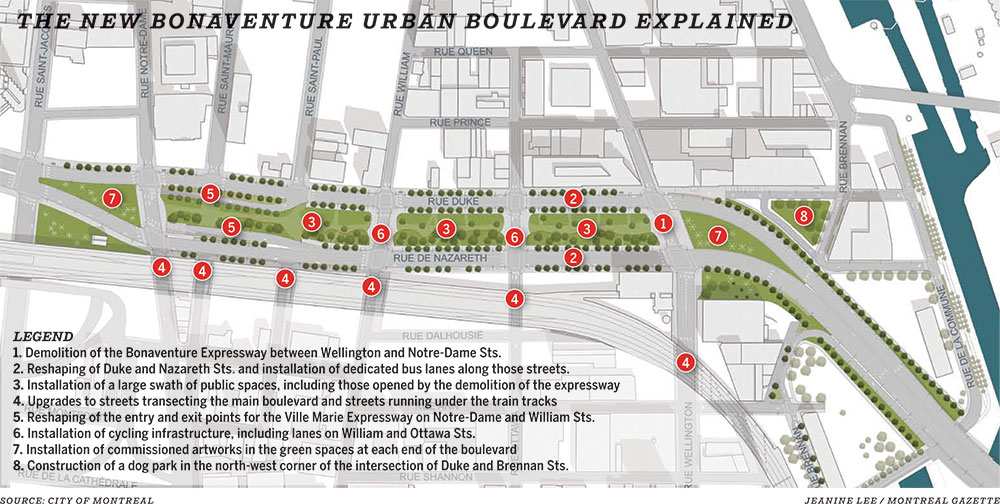History and Context
Built seemingly in haste as a complement to the Champlain Bridge and as the main thoroughfare for the 1967 World’s Fair, the Bonaventure Expressway’s purpose was to ensure traffic could enter into downtown Montreal due to the delay of the Ville-Marie Expressway. Despite the Expo’s considerable success, the Bonaventure Expressway was left nearly useless following its end, ensnaring future waterfront development, significantly isolating the struggling neighborhood of Griffintown on its western edge, and ultimately paving the way for an auto-oriented downtown. The lightly-used 11-lane expressway, with 58,000 travelers per day, was once described as “a drab entry point for motorists arriving from the South Shore, a no man’s land for pedestrians at ground level, and an unattractive zone for developers” (Montreal Gazette).
 Bonaventure Expressway, 1972 Source: Archives de Montréal/Twitter
Bonaventure Expressway, 1972 Source: Archives de Montréal/TwitterProposal
In 2002, the non-profit organization The Société du Havre de Montréal (SHM) formed to oversee the redevelopment of the Montreal harbor front. Working with Montreal 2025, the City’s modernization plan, SHM implemented feasibility reports back in 2003-2004 to look into the benefits of removing the elevated portion of the City-owned Bonaventure Expressway to an at-grade boulevard. Both SHM and Montreal 2025 agreed that removing the expressway would be the best alternative to “launch the reunification, on a humanscale, of the downtown area with its river.” In addition to improving the waterfront development, according to the SHM’s summary of the project, “the new boulevard will enhance the main gateway to the Centre des Affaires [business centre], extend city centre functions... and help rebuild the surrounding areas, while at the same time increasing the City of Montréal’s tax base.”
Known as the Projet Montréal, the demolition of the first 800 meters, from the Peel Basin to Notre-Dame Street, began in 2011. The plan expanded to include the demolition of the remaining elevated section and investing in a light rail link between downtown and the South Shore.
 The new Bonaventure urban boulevard explained. Source: Montreal Gazette
The new Bonaventure urban boulevard explained. Source: Montreal GazetteResults
The promise to replace the highway received wide support, including the blessing of Montreal Mayor Denis Coderre. Montreal began ripping down the Bonaventure Expressway in July 2016 and completed in September 2017, 50 years after the roadway was built, for $143 million.
Two urban boulevards replaced the expressway. Though wide, the new multi-modal thoroughfare of green spaces, parks, and public art is a far cry from the conventional 1950's expressways that cleaved most North American downtowns.
An additional $61 million was allocated to widen two adjacent streets—Duke and Nazareth—to handle additional traffic. At its widest, seven travel lanes of traffic and two bus-only lanes that carry 1,000 bus trips daily each way have replaced the formerly elevated structure. The expressway’s reapportioned right of way dedicated 65% to active transportation and another 10% to public transit. The space apportioned to motor vehicles fell from 70% to 25% with the redesign.
Moreover, the project reached many notable sustainability goals. 95% of the concrete from the former expressway was reused. The landscaping manages stormwater on-site and reduces the urban heat island effect with 300 newly-planted trees and other vegetation. In total, the site achieved a SITES sustainable landscape certification and the Award of Excellence in Urbanism 2018 from the Canadian Institute of Planners.
With the expressway removed and replaced with more humane surface streets and urban amenities, the City of Montreal can continue to reconnect the City to its waterfront.
 Median Linear Park Source: CityLab
Median Linear Park Source: CityLab


















